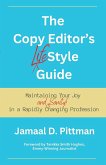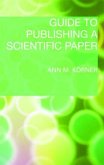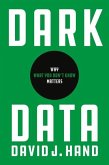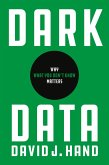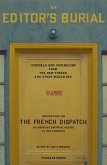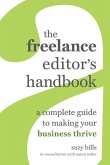Michael Hochberg (Distinguished Re Distinguished Research Director
Editor's Guide to Writing and Publishing Science
Michael Hochberg (Distinguished Re Distinguished Research Director
Editor's Guide to Writing and Publishing Science
- Broschiertes Buch
- Merkliste
- Auf die Merkliste
- Bewerten Bewerten
- Teilen
- Produkt teilen
- Produkterinnerung
- Produkterinnerung
This contemporary guide is packed full of expert tips and suggestions which will make the reader think in a fresh, creative, and novel way about writing and publishing science.
Andere Kunden interessierten sich auch für
![The Copy Editor's (Life)Style Guide The Copy Editor's (Life)Style Guide]() Jamaal PittmanThe Copy Editor's (Life)Style Guide34,99 €
Jamaal PittmanThe Copy Editor's (Life)Style Guide34,99 €![Guide to Publishing a Scientific Paper Guide to Publishing a Scientific Paper]() Ann M. KornerGuide to Publishing a Scientific Paper39,99 €
Ann M. KornerGuide to Publishing a Scientific Paper39,99 €![Dark Data Dark Data]() David J. HandDark Data34,99 €
David J. HandDark Data34,99 €![Dark Data Dark Data]() David J. HandDark Data25,99 €
David J. HandDark Data25,99 €![An Editor's Burial An Editor's Burial]() X Various AuthorsAn Editor's Burial9,99 €
X Various AuthorsAn Editor's Burial9,99 €![The Freelance Editor's Handbook The Freelance Editor's Handbook]() Suzy BillsThe Freelance Editor's Handbook30,99 €
Suzy BillsThe Freelance Editor's Handbook30,99 €![The Scientist's Guide to Writing, 2nd Edition The Scientist's Guide to Writing, 2nd Edition]() Stephen B. HeardThe Scientist's Guide to Writing, 2nd Edition31,99 €
Stephen B. HeardThe Scientist's Guide to Writing, 2nd Edition31,99 €-
-
-
This contemporary guide is packed full of expert tips and suggestions which will make the reader think in a fresh, creative, and novel way about writing and publishing science.
Produktdetails
- Produktdetails
- Verlag: Oxford University Press
- Seitenzahl: 268
- Erscheinungstermin: 1. September 2019
- Englisch
- Abmessung: 244mm x 170mm x 15mm
- Gewicht: 520g
- ISBN-13: 9780198804796
- ISBN-10: 0198804792
- Artikelnr.: 55457224
- Herstellerkennzeichnung
- Libri GmbH
- Europaallee 1
- 36244 Bad Hersfeld
- gpsr@libri.de
- Verlag: Oxford University Press
- Seitenzahl: 268
- Erscheinungstermin: 1. September 2019
- Englisch
- Abmessung: 244mm x 170mm x 15mm
- Gewicht: 520g
- ISBN-13: 9780198804796
- ISBN-10: 0198804792
- Artikelnr.: 55457224
- Herstellerkennzeichnung
- Libri GmbH
- Europaallee 1
- 36244 Bad Hersfeld
- gpsr@libri.de
Michael Hochberg is Distinguished Research Director with the Centre National de la Recherche Scientifique in Montpellier, France, and External Professor with the Santa Fe Institute. He has over 30 years of experience working in both fundamental and applied biology, studying the ecology and evolution of infectious diseases and cancers. He has published over 100 articles in leading journals, and co-edited numerous special issues and books. Michael co-founded Ecology Letters in 1998 and served as its Chief Editor until 2009.
Part I
Before you begin
1: Planting your flag
2: Quality and productivity
3: Citing, reading and searching
4: Avoiding plagiarism
Part II
Writing a great paper
5: The writing mind-set
6: The start
7: Use Models!
8: IMRaD
9: The vitrine
10: The puzzle
11: Emphasis and finesse
Part III
Choosing where to publish
12: How journals operate
13: Who really decides?
14: What to expect from journal service
15: Choices in publishing
16: Choosing a journal
Part IV
Submission and decision
17: Authorship
18: The cover letter
19: The publication decision
20: Data archiving and sharing
Part V
Challenges
21: Peer review
22: The cost of publishing
23: Use of citation metrics
24: Disposable science
Part VI
Opportunities
25: Developing your career
26: Collaborating
27: Writing reviews, opinions and commentaries
28: Reviewing manuscripts
29: Social media
30: Old dogs, new tricks
Before you begin
1: Planting your flag
2: Quality and productivity
3: Citing, reading and searching
4: Avoiding plagiarism
Part II
Writing a great paper
5: The writing mind-set
6: The start
7: Use Models!
8: IMRaD
9: The vitrine
10: The puzzle
11: Emphasis and finesse
Part III
Choosing where to publish
12: How journals operate
13: Who really decides?
14: What to expect from journal service
15: Choices in publishing
16: Choosing a journal
Part IV
Submission and decision
17: Authorship
18: The cover letter
19: The publication decision
20: Data archiving and sharing
Part V
Challenges
21: Peer review
22: The cost of publishing
23: Use of citation metrics
24: Disposable science
Part VI
Opportunities
25: Developing your career
26: Collaborating
27: Writing reviews, opinions and commentaries
28: Reviewing manuscripts
29: Social media
30: Old dogs, new tricks
Part I
Before you begin
1: Planting your flag
2: Quality and productivity
3: Citing, reading and searching
4: Avoiding plagiarism
Part II
Writing a great paper
5: The writing mind-set
6: The start
7: Use Models!
8: IMRaD
9: The vitrine
10: The puzzle
11: Emphasis and finesse
Part III
Choosing where to publish
12: How journals operate
13: Who really decides?
14: What to expect from journal service
15: Choices in publishing
16: Choosing a journal
Part IV
Submission and decision
17: Authorship
18: The cover letter
19: The publication decision
20: Data archiving and sharing
Part V
Challenges
21: Peer review
22: The cost of publishing
23: Use of citation metrics
24: Disposable science
Part VI
Opportunities
25: Developing your career
26: Collaborating
27: Writing reviews, opinions and commentaries
28: Reviewing manuscripts
29: Social media
30: Old dogs, new tricks
Before you begin
1: Planting your flag
2: Quality and productivity
3: Citing, reading and searching
4: Avoiding plagiarism
Part II
Writing a great paper
5: The writing mind-set
6: The start
7: Use Models!
8: IMRaD
9: The vitrine
10: The puzzle
11: Emphasis and finesse
Part III
Choosing where to publish
12: How journals operate
13: Who really decides?
14: What to expect from journal service
15: Choices in publishing
16: Choosing a journal
Part IV
Submission and decision
17: Authorship
18: The cover letter
19: The publication decision
20: Data archiving and sharing
Part V
Challenges
21: Peer review
22: The cost of publishing
23: Use of citation metrics
24: Disposable science
Part VI
Opportunities
25: Developing your career
26: Collaborating
27: Writing reviews, opinions and commentaries
28: Reviewing manuscripts
29: Social media
30: Old dogs, new tricks



